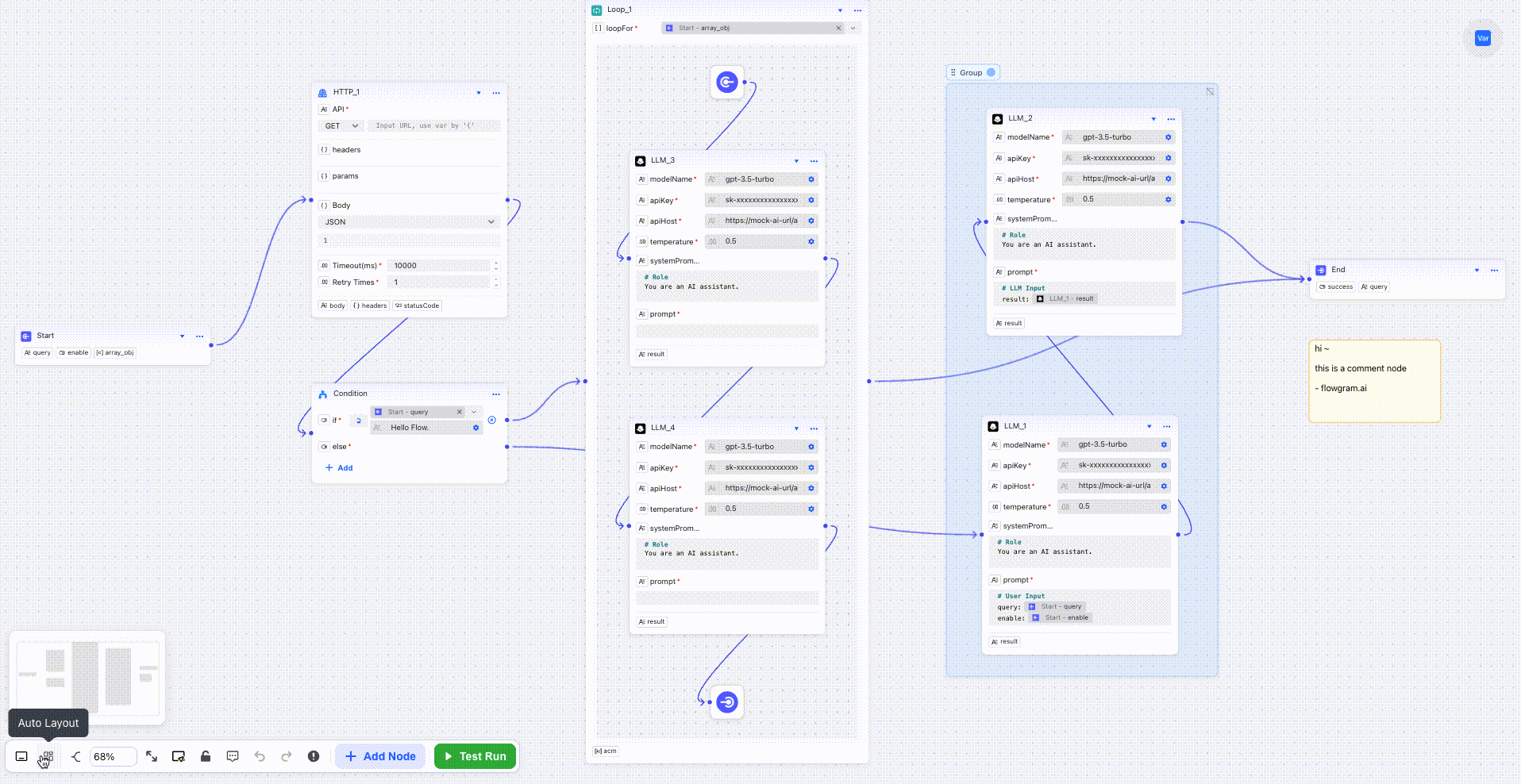@flowgram.ai/free-auto-layout-plugin
An automatic layout plugin based on the Dagre algorithm that provides intelligent node arrangement functionality for free layout canvases.
Features
- Based on Dagre directed graph layout algorithm, automatically calculates optimal node positions
- Supports multiple layout directions (left-to-right, top-to-bottom, etc.)
- Configurable node spacing, margins, and other layout parameters
- Supports recursive layout for nested containers
- Provides animation effects and view adaptation functionality
- Integrates with history system, supports undo/redo operations

Quick Start
- Installation
npm install @flowgram.ai/free-auto-layout-plugin
- Register Plugin
The plugin registration method is basically the same as other flowgram plugins. Just ensure not to create duplicates and pass it to the corresponding FreeLayoutEditorProvider.
import { createFreeAutoLayoutPlugin } from '@flowgram.ai/free-auto-layout-plugin';
const editorProps = useMemo(() => ({
plugins: () => [
createFreeAutoLayoutPlugin({
layoutConfig: {
rankdir: 'LR', // Layout direction: left to right
nodesep: 100, // Node spacing
ranksep: 100, // Rank spacing
}
})
]
}), []);
return (
<FreeLayoutEditorProvider {...editorProps}>
<EditorRenderer />
</FreeLayoutEditorProvider>
)
- Use in React Components
You can also trigger auto layout in components using utility classes:
import { WorkflowAutoLayoutTool } from '@flowgram.ai/free-layout-editor';
const AutoLayoutButton = () => {
const tools = usePlaygroundTools();
const playground = usePlayground();
const handleAutoLayout = async () => {
await tools.autoLayout({
enableAnimation: true, // Enable animation effects
animationDuration: 1000, // Animation duration
disableFitView: false, // Auto fit view after layout
});
}
return (
<button onClick={handleAutoLayout}>
Auto Layout
</button>
);
};
- Use Auto Layout Service
Execute layout by obtaining AutoLayoutService instance through dependency injection:
import { AutoLayoutService } from '@flowgram.ai/free-auto-layout-plugin';
class MyLayoutService {
@inject(AutoLayoutService)
private autoLayoutService: AutoLayoutService;
async performAutoLayout() {
await this.autoLayoutService.layout({
enableAnimation: true, // Enable animation effects
animationDuration: 1000, // Animation duration
disableFitView: false, // Auto fit view after layout
});
}
}
Configuration Options
LayoutConfig
Configuration parameters for the layout algorithm:
interface LayoutConfig {
/** Layout direction */
rankdir?: 'TB' | 'BT' | 'LR' | 'RL';
/** Alignment */
align?: 'UL' | 'UR' | 'DL' | 'DR';
/** Node separation within same rank */
nodesep?: number;
/** Edge separation */
edgesep?: number;
/** Rank separation */
ranksep?: number;
/** Horizontal margin */
marginx?: number;
/** Vertical margin */
marginy?: number;
/** Cycle removal algorithm */
acyclicer?: string;
/** Ranking algorithm */
ranker?: 'network-simplex' | 'tight-tree' | 'longest-path';
}
LayoutOptions
Options for layout execution:
interface LayoutOptions {
/** Container node, defaults to root node */
containerNode?: WorkflowNodeEntity;
/** Function to get follow node */
getFollowNode?: GetFollowNode;
/** Disable auto fit view */
disableFitView?: boolean;
/** Enable animation effects */
enableAnimation?: boolean;
/** Animation duration (milliseconds) */
animationDuration?: number;
/** Node filter function to control which nodes participate in layout calculation */
filterNode?: (params: { node: WorkflowNodeEntity; parent?: WorkflowNodeEntity }) => boolean;
}
Layout Algorithm
Dagre Algorithm
The plugin is implemented based on the Dagre library, which is a JavaScript library specifically designed for directed graph layout. Algorithm features:
- Hierarchical Layout: Organizes nodes into different levels based on dependency relationships
- Minimize Crossings: Attempts to minimize line crossings
- Even Distribution: Evenly distributes nodes while satisfying constraints
Layout Process
- Graph Construction: Converts workflow nodes and connections into Dagre graph structure
- Rank Calculation: Calculates levels (ranks) based on node dependencies
- Order Optimization: Optimizes node order within each level to reduce crossings
- Position Calculation: Calculates final coordinate positions for each node
- Animation Execution: If animation is enabled, smoothly transitions to new positions
Advanced Usage
Custom Follow Node
You can customize node following relationships through the getFollowNode function:
const layoutOptions: LayoutOptions = {
getFollowNode: (node: LayoutNode) => {
// Return the node ID that should follow the current node
if (node.flowNodeType === 'comment') {
return getNearestNode(node);
}
return undefined;
}
};
await tools.autoLayout(layoutOptions);
Node Filtering
You can control which nodes participate in layout calculation through the filterNode function:
const layoutOptions: LayoutOptions = {
filterNode: ({ node, parent }) => {
// Filter out specific types of nodes
if (node.flowNodeType === 'comment') {
return false;
}
// Filter based on parent node conditions
if (parent && parent.flowNodeType.type === 'group') {
return false;
}
return true; // Include all nodes by default
}
};
// Execute layout with filter options
await tools.autoLayout(layoutOptions);
Layout Only for the Specified Container
The plugin supports recursive layout for a specified container and automatically handles node arrangement within the container:
// Execute layout for specific container
await autoLayoutService.layout({
containerNode: specificContainerNode,
enableAnimation: true,
});
FAQ
Q: How to trigger auto layout during initialization?
A: Call the ctx.tool.autoLayout() method after the canvas rendering is complete to trigger auto layout.
const editorProps = useMemo(() => ({
onAllLayersRendered: (ctx) => {
ctx.tool.autoLayout({
enableAnimation: false, // Disable animation during initialization for better user experience
}
);
}
}), []);
Q: How to implement custom layout directions?
A: Method 1: Register AutoLayout plugin in EditorProps and control layout direction through the rankdir parameter:
import { createFreeAutoLayoutPlugin } from '@flowgram.ai/free-auto-layout-plugin';
const editorProps = useMemo(() => ({
plugins: () => [
createFreeAutoLayoutPlugin({
layoutConfig: {
rankdir: 'TB', // Top to bottom
// rankdir: 'LR', // Left to right (default)
// rankdir: 'RL', // Right to left
// rankdir: 'BT', // Bottom to top
}
})
]
}), []);
Method 2: Pass layout configuration through the layoutConfig parameter when calling the autoLayout method:
const tools = usePlaygroundTools();
const playground = usePlayground();
const handleAutoLayout = async () => {
await tools.autoLayout({
layoutConfig: {
rankdir: 'TB', // Top to bottom
// rankdir: 'LR', // Left to right (default)
// rankdir: 'RL', // Right to left
// rankdir: 'BT', // Bottom to top
}
});
}
Q: How to optimize layout animation stuttering?
A: For complex workflows, it's recommended to disable animation or reduce animation duration:
layoutOptions: {
enableAnimation: false, // Disable animation
// or
animationDuration: 150, // Reduce animation duration
}
